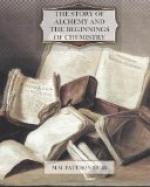The minute particles of two of the substances for many years classed as elements give off electrons; uranium and thorium are radio-active. Electrons are produced by sending an electric discharge through very small traces of different gases, using electrodes of different metals. Electrons are also produced by exposing various metals to the action of ultra-violet light, and by raising the temperature of various metals to incandescence. Electrons are always identical, whatever be their source. Three questions suggest themselves. Can the atoms of all the elements be caused to give off electrons? Are electrons normal constituents of all elementary atoms? Are elementary atoms collocations of electrons? These questions are included in the demand—Is it possible “to imagine a model which has in it the potentiality of explaining” radio-activity and other allied phenomena, as well as all other chemical and physical properties of elements and compounds? These questions are answerable by experimental investigation, and only by experimental investigation. If experimental inquiry leads to affirmative answers to the questions, we shall have to think of atoms as structures of particles much lighter than themselves; we shall have to think of the atoms of all kinds of substances, however much the substances differ chemically and physically, as collocations of identical particles; we shall have to think of the properties of atoms as conditioned, in our final analysis, by the number and the arrangement of their constitutive electrons. Now, if a large probability were established in favour of the view that different atoms are collocations of different numbers of identical particles, or of equal numbers of differently arranged identical particles, we should have a guide which might lead to methods whereby one collocation of particles could be formed from another collocation of the same particles, a guide which might lead to methods whereby one element could be transformed into another element.
To attempt “to imagine a model which has in it the potentiality of explaining” radio-activity, the production of kathode rays, and the other chemical and physical properties of elements and compounds, might indeed seem to be a hopeless undertaking. A beginning has been made in the mental construction of such a model by Professor Sir J.J. Thomson. To attempt a description of his reasoning and his results is beyond the scope of this book.[14]
[14] The subject is discussed in
Sir J.J. Thomson’s
Electricity and Matter.
The facts that the emanation from radium compounds spontaneously gives off very large quantities of energy, and that the emanation can easily be brought into contact with substances on which it is desired to do work, suggested to Sir William Ramsay that the transformation of compounds of one element into compounds of another element might possibly be effected by enclosing a solution of a compound along with radium emanation




